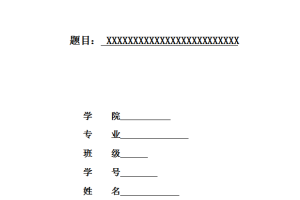摘 要
伴随经济全球化和金融国际化的不断加深,各国之间的经济贸易联系日益密切,国际资本流动更加频繁,经济发展的不稳定因素也在逐渐增多,因此,外汇储备对于维护和保障各国经济健康发展的作用越来越重要。2006年2月,我国外汇储备超过万亿美元,首次超过日本成为世界上拥有外汇储备最多的国家,截止2012到年年底,我国外汇储备达到3.31万亿美元,增长速度世界罕见。充足的外汇储备不仅能够满足我国对外贸易和稳定汇率的需求,还可以增强抵御外部冲击的能力,促进我国经济的稳定发展。但是,高额的外汇储备也会给我国经济发展带来一定的消极影响。高额的外汇储备会加剧国内的流动性过剩,引起通货膨胀的发生;高额的外汇储备会加大国内货币供给的内生性,降低货币政策的有效性和独立性,影响经济的宏观调控能力;高额的外汇储备会加强人民币升值的预期,造成人民币升值、外汇储备增长、国内外经济失衡三者之间的恶性循环等。因此,如何确定我国外汇储备的适度规模并对其加以缓解控制就成为我国经济发展必须面临的重要问题。
本文以我国外汇储备规模为研究对象,探讨当前我国外汇储备的合理规模以及政策选择。本文首先介绍了外汇储备的概况及有关外汇储备规模的理论综述。根据我国实际情况,从我国的汇率机制入手,从制度安排方面对我国近年来外汇储备激增的现象进行了解释分析。在对影响我国外汇储备需求的经济决定因素进行了比较具体分析研究的同时,提出了我国外汇储备需求的长、短期模型,并进行了相关的检验。在对我国外汇储备适度规模内涵的理解基础上,对我国的外汇储备规模的适度区间进行了确定,对有关的比率进行了分析,得出我国目前外汇规模过度的结论。最后,针对我国过度外汇储备的实际情况,在分析其利弊得失的基础上,对如何实现我国最优外汇储备提出了相应的政策建议。
关键词:外汇储备;适度规模;外汇储备;
Concomitant of economic globalization and internationalization of financial deepening, the increasingly close economic and trade ties between the countries, international capital flows have become more and more frequent, the unstable factors of economic development also gradually increased. Therefore, the foreign exchange reserve to maintain and protect the healthy development of national economy is becoming more and more important. In February 2006, China’s foreign exchange reserves more than trillion dollars, for the first time surpassed Japan to become the world’s largest foreign exchange reserves, and by the end of 2012 to the end of the year, China’s foreign exchange reserves reached $3.31 trillion, the growth rate is rare in the world. Adequate foreign exchange reserves can not only meet China’s foreign trade and exchange rate stability, but also can enhance the ability to withstand external shocks, and promote the stable development of China’s economy. However, the high foreign exchange reserves will also bring some negative effects to the economic development of china. High foreign exchange reserves will exacerbate the domestic excess liquidity, inflation; a large amount of foreign exchange reserves will increase the domestic money supply endogenous and lower expectations of monetary policy effectiveness and independence, the economic impact of macroeconomic regulation and control ability, high level of foreign exchange reserves will strengthen the appreciation of the renminbi, caused by the appreciation of the renminbi, the growth of foreign exchange reserves, domestic and international economic imbalances the vicious circle between etc.. Therefore, how to determine the appropriate scale of China’s foreign exchange reserves and to ease control becomes an important problem in China’s economic development must face.
In this paper, China’s foreign exchange reserves as the research object, to explore the reasonable scale of the current China’s foreign exchange reserves and the selection of policy. This paper first introduces the overview of theory of foreign exchange reserves and foreign exchange reserves scale. According to the actual situation in our country, starting from the exchange rate mechanism in China, from the institutional arrangements of China to explain the analysis of foreign exchange reserves surge phenomenon in recent years. At the same time, the economic factors that affect the demand of foreign exchange reserve in China are analyzed and studied, the long and short term model of China’s foreign exchange reserve demand is put forward, and the relevant test is carried out. In based on the understanding of the connotation of the appropriate scale of China’s foreign exchange reserves, on China’s foreign exchange reserves appropriate interval were determined. The has carried on the analysis to the related ratio, that China’s current foreign exchange over the scale of conclusion. Finally, in view of the actual situation of China’s excessive foreign exchange reserves, based on the analysis of the pros and cons of the basis of how to achieve the optimal foreign exchange reserves of our country put forward the corresponding policy recommendations.
KEY WORDS: Foreign exchange reserve; Appropriate scale; Foreign exchange reserve;
目 录
ABSTRACT………………………………………………….. 3
1.3主要研究内容及方法………………………………….. 11
2我国外汇储备适度规模相关理论………………………………. 12
2.1关于我国外汇规模的理论综述…………………………… 12
3转型时期我国外汇储备适度规模的现状以及发展问题分析…………… 15
3.1转型时期我国外汇储备适度规模发展历程………………….. 15
3.2转型时期我国外汇储备适度规模的发展现状………………… 19
3.2.1外汇储备的规模现状分析………………………….. 19
3.2.2 外汇储备的结构现状分析…………………………. 20
4影响我国外汇储备适度规模的因素…………………………….. 21
4.1我国外汇储备规模变动情况…………………………….. 21
4.2影响我国外汇储备规模需求因素的分析……………………. 22
4.2.1 国际收支情况………………………………….. 22
4.2.4持有外汇储备的机会成本………………………….. 23
4.3影响我国外汇储备规模供给因素的分析……………………. 24
4.3.3 政府干预外汇市场所得的外汇……………………… 24
5解决转型时期我国外汇储备适度规模发展问题的途径………………. 25
5.1控制外汇储备规模的过快增长…………………………… 25
5.1.1从经常项目上减缓外汇储备的过快增长……………….. 25
5.1.2从资本项目上控制外汇储备规模的过快增长……………. 26
5.1.3深化外汇体制改革……………………………….. 26
5.2.1实现外汇储备币种结构多元化………………………. 27
5.2.2实现外汇储备资产多样化………………………….. 27
5.2.3增加黄金储备比重……………………………….. 27
5.3提高外汇储备的经营水平………………………………. 27





